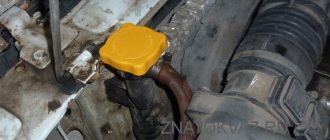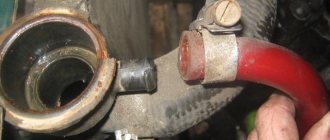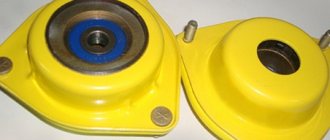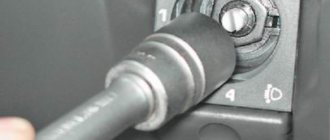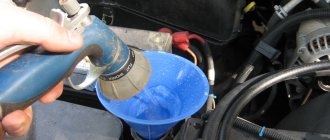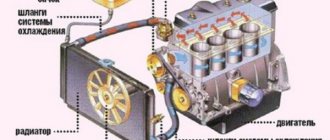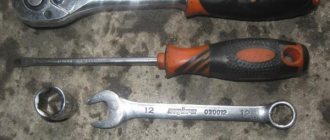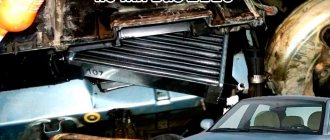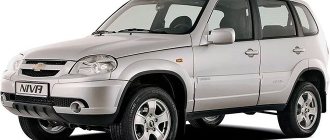Antifreeze is a coolant used in automobile internal combustion engines. Due to its resistance to low temperatures, excellent heat transfer properties, and low cost, it is very popular among car owners. But, like any other technical fluid, this refrigerant must be replaced periodically. We will talk about when this needs to be done in this article. We will also look at how to drain antifreeze from a VAZ-2110 using the example of eight- and sixteen-valve “ten” engines.
When and why do you need to change the refrigerant?
According to the recommendations of the car manufacturer, the coolant in the engine should be replaced every 75 thousand kilometers, or 3 years of operation, regardless of how long the car has been driven. In addition, the refrigerant must be replaced if the car owner detects signs that it has lost its properties, changed color or consistency.
If this is not done, the engine is at risk of overheating. Moreover, low-quality coolant provokes scale deposits in the channels of the cooling jacket, in the main and heating radiators.
Antifreeze and antifreeze: differences
Coolants from different manufacturers differ in their production and manufacturing processes, as well as in the additive packages they contain.
The recommendations specified in the operating manual or service book (name, manufacturer, fluid class, etc.) will help you choose the right fluid.
Depending on the production technology, there are three types of coolant:
- traditional production technology (the liquid contains additives based on salts of inorganic acids);
- carboxylate production technology (the liquid contains additives based on organic salts);
- hybrid production technology (creation of additives based on carbon salts with a low content of phosphates and silicates).
Antifreeze is produced using traditional technology, and antifreeze is produced using carboxylate technology. Both antifreeze and antifreeze have a number of positive properties (increased efficiency of the internal combustion engine cooling system, anti-corrosion properties, etc.).
For this reason, the choice of fluid can be made by the car owner himself. Moreover, in practice, the VAZ 2110 is not an expensive car that requires the latest generation of antifreeze to be poured into it. Moreover, antifreeze is poured into the engine at the factory.
Often, in the future, owners continue to fill with more affordable domestic antifreeze, rather than antifreeze. However, it also happens that owners deliberately switch from antifreeze to antifreeze. It is important to remember that you cannot mix antifreeze and antifreeze, so before such transitions from one type to another, the cooling system must be thoroughly flushed.
Which antifreeze to choose
It is necessary to buy antifreeze only in specialized stores, and give preference to those manufacturers whose reputation is beyond doubt. As for the choice, it is better to use the type and brand of coolant that, again, is recommended by the car manufacturer.
Let's take, for example, Russian-made antifreeze A-40M, or A-65M. Both of these fluids are ideal for any “tens” engine. The refrigerant marking letters have the following designation: A - automotive, M - modernized.
The numbers are the freezing temperature of the antifreeze. A concentrate is also available for sale. It is designated “Antifreeze AM”. All of the listed liquids, which is important, are produced in accordance with GOST 28084-89
Is there a difference in the processes of draining antifreeze in eight- and sixteen-valve engines?
There is a difference, and it is significant. The fact is that the “tens” engines have different designs. In terms of draining antifreeze, a VAZ-2110 with 8 valves is more convenient than a dozen with sixteen valves. The first has a coolant drain plug located on the front of the cylinder block. To get to it, you don’t need to drive the car into the inspection hole or remove the protection. But for sixteen-valve power units, the plug is located at the bottom, and can even be closed by the starter, so before draining the antifreeze from the VAZ-2110, you will need to drive the car into a pit (overpass), remove both the protection and the starter. Let's take a closer look at this process for each engine.
We drain the antifreeze ourselves
To drain antifreeze and fill in new fluid, we need a drain container with a volume of at least 7.5-8 liters.
You will also need keys and flushing fluid if the system needs to be cleaned.
To refill the system, 7–7.5 liters of finished liquid . This must be taken into account if we pour the concentrate and dilute it with distilled water. It is advisable to carry out the work with gloves, since antifreeze is toxic. Before replacement, we will conduct a detailed inspection of the system, eliminate fluid leaks, and replace failed pipes and clamps.
Algorithm
We carry out replacements on a cold engine according to the following algorithm:
- We place the car on a level surface; if possible, we place the car so that its front part is slightly higher than the rear.
- Remove the negative terminal from the battery.
- We install the heater valve in the extreme right, hottest position.
Turn the heater control knob to the right until it stops.
Unscrew the screws securing the engine protection.
Unscrew the plug at the bottom of the radiator.
Using a 13 key, unscrew the plug on the front side of the cylinder block.
Disconnect the fluid supply hose to the throttle body.
Fill with antifreeze to the required level.
Warm up the engine to operating temperature.
Check the coolant level in the expansion tank.
Draining antifreeze on an eight-valve engine
Necessary tools and means:
- keys for 10 and 13;
- funnel with a hose (can be made from a plastic bottle);
- container for collecting old refrigerant (canister, bucket);
- additional capacity for 2-3 liters (you can use a cut-off plastic bottle);
- dry rag.
Before draining the antifreeze from the VAZ-2110 block, it is necessary to position the car so that its rear part is slightly raised. To do this, you can park the car downhill, or drive the rear wheels onto the curb. This will allow the coolant to drain faster.
It is also advisable to remove the negative terminal from the battery, especially if you are dealing with an injection engine. Next we follow this algorithm:
- Unscrew the cap of the expansion tank.
- We place a funnel under the drain hole and lead the hose through the engine protection to any convenient place where you can place a container to collect the refrigerant.
- Using a 10mm wrench, carefully unscrew the drain plug and wait for the coolant to drain.
- After this, we place an additional container under the radiator cap.
- Unscrew the plug and drain the remaining refrigerant.
- When all the liquid has drained, tighten the plugs and we can start pouring new antifreeze.
Procedure for replacing fluid in the cooling system
Before adding any coolant, close the engine and radiator caps, and then fill the system with antifreeze. It will be required so much that the liquid level in the expansion tank reaches the point where the belt fastening passes.
Upon completion of work, tightly screw the cap of the expansion tank and return the hose leading to the heating system. Please note that high pressure occurs in this assembly. If you do not tighten the plug tightly enough, it may break off during operation. This will inevitably lead to antifreeze leakage.
Before starting the engine, perform reverse assembly - install the ignition module and return the negative terminal to the battery. After the work described in this section, you can start the engine to warm up. You shouldn’t start driving right away - let the engine run for a while, and then check the fluid level in the expansion tank. If there were air pockets in the system, the amount of antifreeze will decrease. The top edge of the fluid will not reach the location of the belt on the reservoir. In this case, let the car sit for a while and then add antifreeze.
Sometimes, by warming up the power plant, the air plugs are not pressed through. In this case, it is necessary to repeat the procedure with the hose (described in the previous section), at the same time open the cap of the expansion tank. After excess air has escaped, it is necessary to add antifreeze to the required level.
How to drain antifreeze from a VAZ-2110 injector (16 valves)
Necessary tools and means:
- keys for 10 and 13;
- capacity for 8-10 liters (canister or bucket);
- dry rag.
In order to drain the antifreeze, the VAZ-2110 (16 valves) needs to be driven onto an inspection hole or overpass. Further work is carried out in the following order:
- Disconnect the negative wire on the battery.
- We unscrew the plug on the expansion tank.
- We go down into the pit, use a 10mm wrench to unscrew the bolts securing the engine protection. We remove the protection.
- We unscrew the drain plug on the radiator, first placing a container under it. We wait until all the antifreeze in the heat exchanger drains.
- If in your car the gearbox is driven using a cable, before draining the antifreeze from the VAZ-2110, you will have to remove the starter. The drain plug is located directly below it. To do this, you need to disconnect the block of wires from the connector of the solenoid relay, remove the protective cap from the nut securing the positive wire, unscrew it, remove the wire, and then unscrew the three bolts securing the starter. After this, place a container under the plug, unscrew it and drain the coolant. If the gearbox is controlled by traction, there is no need to remove the starter.
Reasons for replacement
When replacing antifreeze on a VAZ 2110, you must adhere to several rules. The engine must be cold, antifreeze is a toxic liquid; when working with it, it is necessary to avoid contact with the eyes, mouth and prolonged contact with the skin.
Antifreeze, coolant (antifreeze) is a special composition of automotive fluid based on ethylene glycol. Used in the cooling system of an internal combustion engine (ICE) for operation at low ambient temperatures. There may be several reasons for replacing antifreeze:
Cooling system VAZ 2110
Has everything merged?
Removing all the refrigerant from the system is quite problematic, because it is a whole complex of channels, tubes and hoses. In general, this is not required during normal routine replacement, but if, for example, you are going to replace antifreeze with antifreeze, or vice versa, or flush the cooling system, you will have to try to remove the liquid from the engine as much as possible. But how to completely drain the antifreeze? The VAZ-2110 is not such a difficult car for this. This can be done using a regular car compressor, or, as a last resort, a pump.
We take the compressor, connect its hose through some homemade adapter to one of the “nipple” on the expansion tank, having first removed the hose from it and “plugged” it, and begin to pump air into the system. Almost all the liquid remaining in the hoses, engine cooling jacket, and radiator tanks will come out through the drain holes.
Note to car owners
Please know that if you do not replace the antifreeze in a timely manner, then premature corrosion begins in the channels of the engine block and its head and, as a result, the engine life is significantly reduced:
- This affects the cylinder head the most.
- Working as a car mechanic, I often had to disassemble engines and observe the head cooling channels eaten away by corrosion
- After such a spectacle, anyone will feel scared for their car; you will certainly forget to change the antifreeze in a timely manner.
- At each scheduled maintenance, you need to check the level and appearance of antifreeze (more often if possible)
Important: The antifreeze level must be checked on a cooled engine; the permissible level is within (between) the lower and upper marks on the body of your expansion tank. A slight increase or decrease in this level that occurs when it is cooled or heated is not considered a malfunction; this is absolutely normal. Such level fluctuations are associated with thermal changes in volume (for example, expansion when heated and subsequent decrease in volume when cooled). However, if you notice a gradual decrease in the level with each new check on a cold engine, then you need to look for where the leak is occurring.
You also need to fill it correctly
Now that you know how to drain antifreeze from a VAZ-2110, you can talk about how to properly fill in fresh refrigerant. This process is much simpler than the previous one, but there are some nuances here.
The main task facing a car owner who is pouring coolant into the system is to prevent air locks from occurring in it. No, they are not dangerous for the engine, but they are extremely undesirable, especially in winter, when the “stove” operation is necessary. Plugs create obstacles to the normal circulation of the refrigerant, and in addition, reduce its volume in the system. So it turns out that we filled in 6-7 liters, but the “stove” does not heat as it should. And the troubleshooting begins.
But when filling in antifreeze, all you need to do is disconnect the hose from the throttle assembly and fill until the refrigerant flows out of it. After this, we put the hose on the fitting and continue to fill the liquid to the level. When it is reached, without closing the expansion tank cap, we start the engine, wait until it warms up to operating temperature, and “pump” the hoses going to the cooling radiator, periodically squeezing them with our hands. Air, if there is any, will definitely come out. All you have to do is add liquid to the level.
Choosing coolant
How your car's cooling system works depends on several factors, the main component of which, of course, remains the coolant (water, antifreeze or antifreeze). Not everyone understands that the quality of the liquid in the cooling system determines the stable operation of not only the motor and heater, but also other elements of the cooling system. Therefore, let's decide why antifreeze is better than ordinary water:
- Antifreeze has low specific expansion when heated
- higher boiling point
- Very low crystallization temperature (antifreeze does not freeze, it turns into a gel)
- Antifreeze protects the cooling system from corrosion
- In addition, it has anti-foam properties (practically does not foam)
- Has some lubricating properties (the SOD pump is lubricated with antifreeze)
How does antifreeze differ from antifreeze:
- Antifreeze is an antifreeze; it consists of ethylene glycol in 99% of cases.
- “TOSOL” received its name during the USSR (that’s how the new brand of antifreeze was called), after which it remained so. It turns out antifreeze is a Russian brand of antifreeze
- The antifreeze itself can be diluted or a concentrate (look at the label carefully), which must be diluted before using it in the car.
- The antifreeze resource is slightly longer due to modern additives that ensure a stable condition and inhibitors that prevent intense corrosion of all metal parts of the engine
What determines the quality of antifreeze:
- The quality of antifreeze is determined by the set of its additives; the properties of antifreeze depend on them
- Buy antifreeze in reliable branded stores from well-known manufacturers, and do not look for a cheap one, so as not to stumble upon a fake
- The color of high-quality antifreeze is not of fundamental importance
- However, you cannot change or add antifreeze of different colors, even if these antifreezes are produced by the same company
- It is all the more questionable to mix antifreezes of the same color, but from different manufacturers.
- Remember, the point is the additives added to the antifreeze, they differ, so no one knows how such a cocktail will behave when mixed
According to the regulations, antifreeze is replaced every five years, or look at the mileage indicated at the beginning of the article, but in practice these figures may differ, depending on the operating conditions of the car, as well as the quality of the antifreeze.
